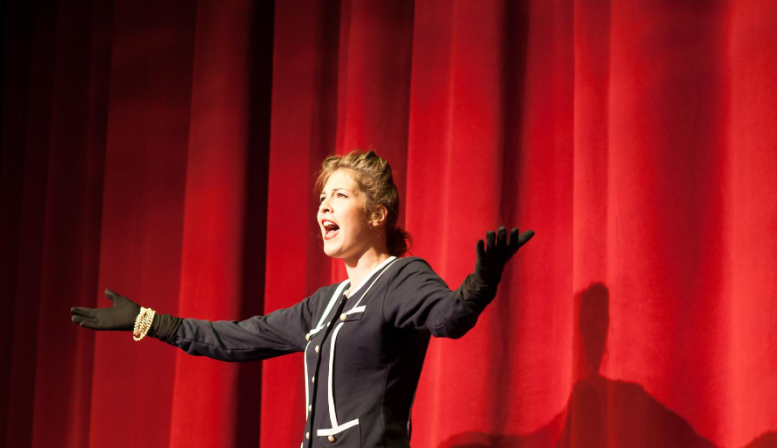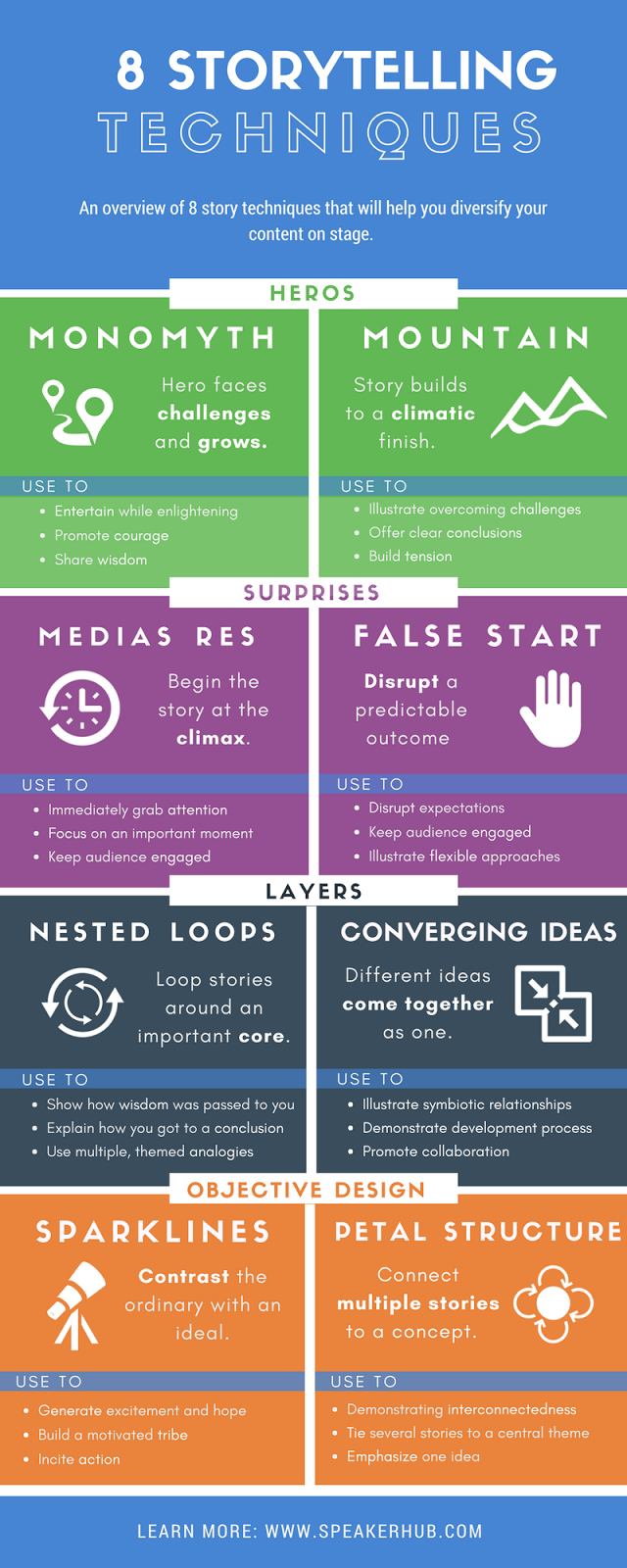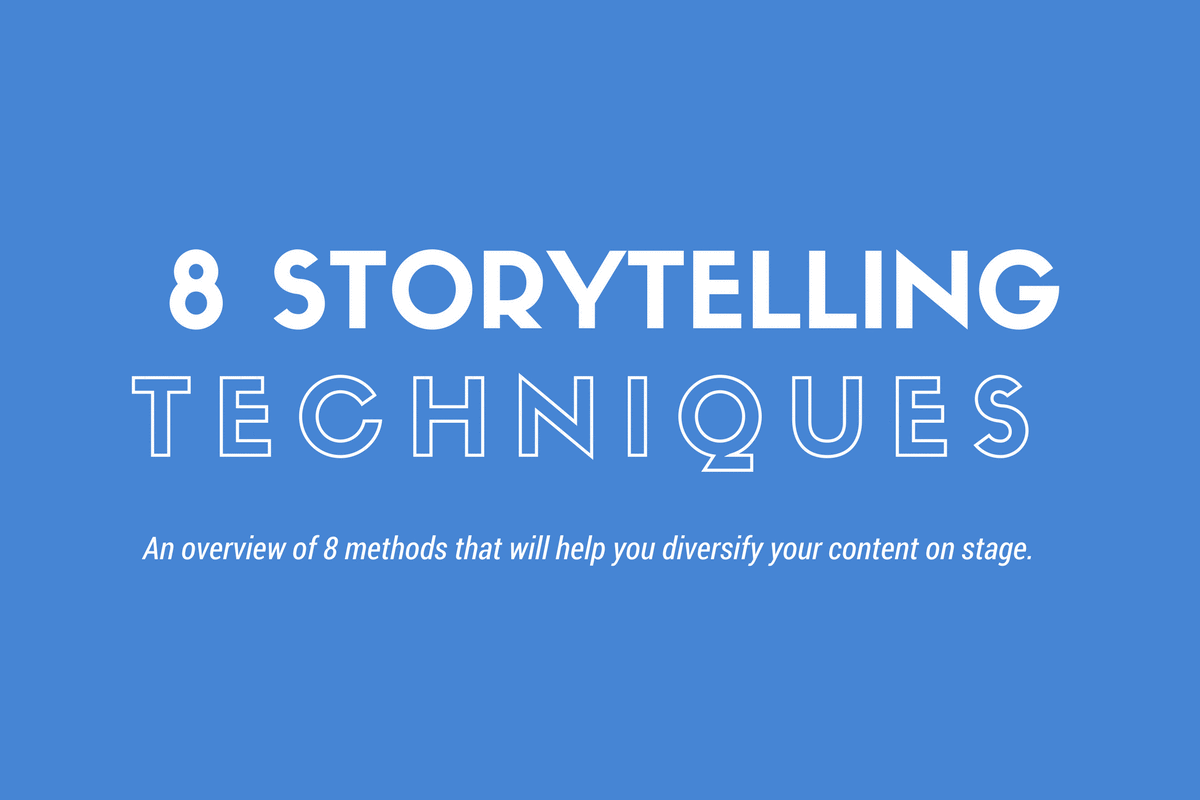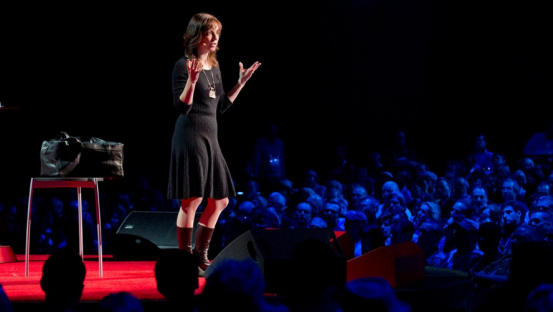8 Storytelling techniques to use on stage

From scientists to social media gurus, the experts agree that storytelling is one of the very best ways for the human brain to process and store information.
We have a tendency to believe that cold hard facts make for more compelling content, and that to prove something you need straight statistics, and that storytelling is fine for films, but not for adeptly sharing key messages.
This is simply a misconception.
“My experiments show that character-driven stories with emotional content result in a better understanding of the key points a speaker wishes to make and enable better recall of these points weeks later. In terms of making impact, this blows the standard PowerPoint presentation to bits.”
-Paul J. Zak, Founding director of the Center for Neuroeconomics Studies
Paul J. Zak explains that in his team’s research, they discovered a link between the synthesis of oxytocin (one of the neurochemicals responsible for motivation and empathy) and listening to character-driven stories.
Additionally, they found that the more oxytocin was released by the brain during these stories, the more willing the audience was to join the cause and help by, for example, donating money to a charity.
So, what makes a great story?
The 3 elements of a great story
1. Great stories are personal
Want your story to really build rapport with your audience? Want to capture their attention? Want to get them on your side?
Talk about your personal experiences. Explore epiphanies you’ve have, what your path to success looked like, what obstacles you faced, and which failures and mistakes you made along the way.
Paint a picture of what the process looked and felt like. Illustrate what happened, and how it affected you personally.
It’s important to note here that there is a substantial difference between reliving your personal experience, and repeating someone else’s story or reading from a script.
When you are diving into your experience, envision yourself being there and what it felt like. It will automatically give your story a multi-dimensional angle, which will have a richer and deeper texture for your audience.
2. Great stories have a purpose
Before you start your story, make sure you have a very clear idea about what you want your audience to get out of it. What is the main point?
Once you have the end in mind, mentally work your way back to the beginning. Which parts are going to emphasize your message? Which parts can you leave out?
Don’t just tell a story to fill up spaces; this is the verbal equivalent of empty calories. Know your goal and use the story to get you there.
3. Great stories are sensory descriptive
If the audience can’t visualise what you are talking about, the story will flop.
They will be lost (and bored) if your story is dry or abstract.
How do you make a story descriptive?
Use language that is heavy with visuals.
Dive into your senses, and when speaking, use words that will help your audience imagine what it would be like to live the story themselves: to fully understand what it would be like to touch, taste, smell, and hear the elements of your story.
Make the information as interactive as possible.
How to tell a story
Ira Glass, master storyteller and the host of NPR’s This American Life, assures us that storytelling is very simple.
He says a story is just a person saying:
“This happened, and that led to this next thing, and this next thing and so on; one thing following another. And some things in the sequence can be: then that made me think of this, and that made me say this.”
This technique for storytelling is the most straight-forward, simple, and the best place to start.
But it is not the only way to tell a story. In fact, there are dozens of ways to creatively spin a tale, and the different techniques can aid your talk in a variety of ways.
Read below for different storytelling techniques, and when to use them.
8 Storytelling techniques

1. Monomyth
Otherwise known as the “Hero’s Journey.” This is one of the oldest ways to tell a story, and revolves around a character going off into the world, facing a challenge or series of challenges, discovering something, and returning back home with their new found wisdom.
Use to:
- Entertain your audience while enlightening them
- Promote courage and risk taking
- Share wisdom
2. The Mountain
In the mountain structure, everything leads up to one pinnacle moment: the climax (the top of the mountain.) Once the climax is hit, the end of the story comes swiftly. There is no need for these stories to end positively or negatively. It’s structure is very popular for keeping your audience engaged.
Use to:
- Illustrate challenges
- Offer clear conclusions and results to big moments or events
- Build tension and keep the audience engaged
3. Media Res
In this structure, you start at the climax of the story, then backtrack to the beginning. It immediately grabs the attention of your listener, especially if the climax is high action or bizarre. Keep in mind that this is not the best format for long stories, or your audience might forget the climax by the time you get back to it. Use it for short, punchy, exciting stories.
Use to:
- Immediately grab the attention of your audience
- Focus and draw attention to a very important moment
- Keep audience engaged
4. False Start
In this structure, you make it seem like the story is going one way, and will have a predictable outcome (like the success of a project) but then, it doesn’t. For whatever reasons, things do not go as planned and you have to go back to start and say what you did differently (successfully) the second time around.
Use to:
- Disrupt the expectations of your audience, or their paradigm
- Keep audience engaged, and offer them a surprise
- Illustrate the benefit of flexible approaches
5. Nested Loops
In this technique, you layer the stories of different individuals together, into one larger themed story. Instead of telling all the stories separately, you combine them so that the stories fit within each other, with the important part your message being at the centre.
Use to:
- Show how wisdom was passed to you
- Explain how you came to a conclusion or to your key insight
- Use multiple, themed analogies, creating a multidimensional story.
6. Converging Ideas
Exactly as the name implies, with the converging ideas technique, you show how separate people (or teams) added their ideas together to make one bigger, greater idea.
Use to:
- Illustrate how symbiotic relationships can work
- Demonstrate development processes
- Promote group collaboration
7. Sparklines
Nancy Duarte argues that the very best speeches succeed because of this storytelling technique. In this method, you create a contrast between the ordinary, everyday world with an ideal, improved world. You immediately show how adopting a new method or way of thinking can create change.
Use to:
- Generate excitement and hope around an idea
- Motivate your audience
- Incite action
8. Petal Structures
In this structure, you take several seemingly unrelated stories, and tie them together with one idea or theme. By showing the way an idea can affect very different examples, you emphasize the importance of your message.
Use to:
- Demonstrate interconnectedness around an idea
- Tie several stories to a central theme
- Create emphasis on one idea or message.

We would like to thank Ffion Lindsay for her article on storytelling, which outlines many of the above techniques.
Looking for more speaking opportunities? Find out more about creating a speaker profile on SpeakerHub.








